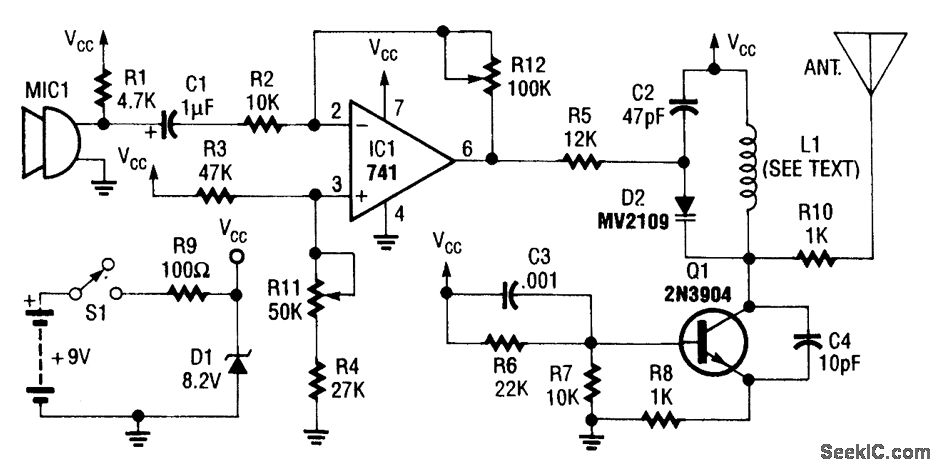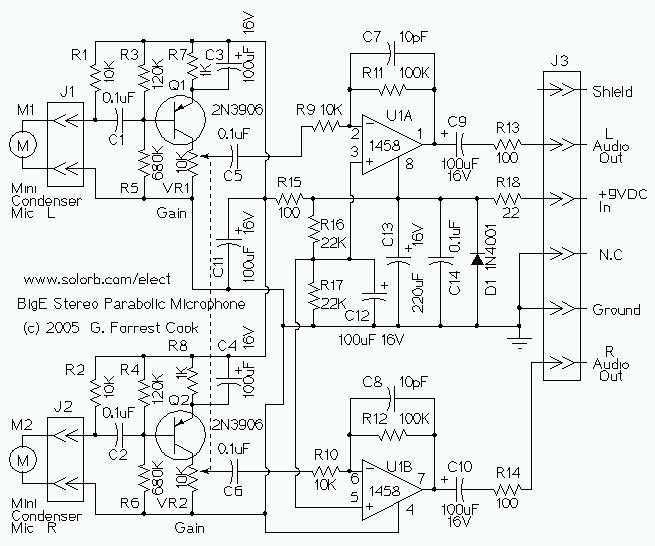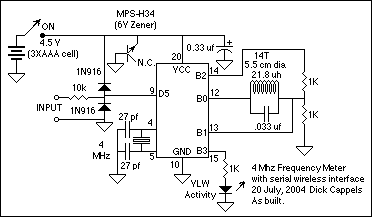
WIRELESS MICROPHONE

An operational amplifier integrated circuit (741) amplifies the audio signal from microphone 1 (MIC1), with resistor R12 determining its gain. The amplified audio signal is then directed to the oscillator circuit, which includes transistor Q1 and associated components. D2 functions as a varactor diode, and the audio signal applied to D2 modulates the frequency of the oscillator signal. Inductor L1 consists of half a turn of #18 gauge wire wound on a half-inch diameter form. The antenna used for transmission is a 12-inch whip.
An operational amplifier (op-amp) such as the 741 is commonly used in audio applications due to its high input impedance and low output impedance, making it ideal for amplifying weak signals from microphones. The gain of the op-amp is controlled by the resistor R12, which can be adjusted to set the desired amplification level for the audio signal captured by MIC1.
Once the audio signal is amplified, it is sent to the oscillator circuit, which is responsible for converting the audio signal into a frequency-modulated (FM) signal. This is achieved through the operation of transistor Q1, which acts as a switch or amplifier in the oscillator circuit. The use of a varactor diode (D2) is critical in this setup, as it allows the frequency of the oscillator to vary based on the audio signal input. The capacitance of the varactor diode changes with the applied voltage, which is influenced by the audio signal, thus resulting in frequency modulation of the oscillator output.
Inductor L1 plays a significant role in the oscillator circuit. Constructed from half a turn of #18 gauge wire on a half-inch diameter form, L1 contributes to the tuning and stability of the oscillator. The inductance value, combined with the capacitance of the varactor diode, determines the oscillation frequency, which is then modulated by the audio signal.
The final output is transmitted through a 12-inch whip antenna, which is designed to efficiently radiate the modulated signal into the surrounding environment. The length of the antenna is optimized for the frequency range of the oscillator, ensuring effective transmission of the audio signal over a distance. Overall, this circuit design effectively combines amplification, modulation, and transmission to create a functional audio transmission system.An op-amp IC (741) amplifies the audio signal from MIC1, and R12 controls its gain. Audio is fed to the oscillator circuit Q1 and related components. D2 is a varactor diode. Audio fed to D2 causes FM of the oscillator signal. L1 is 1/2 turns of #18 wire on a He" diameter form. The antenna is a 12" whip. 🔗 External reference
An operational amplifier (op-amp) such as the 741 is commonly used in audio applications due to its high input impedance and low output impedance, making it ideal for amplifying weak signals from microphones. The gain of the op-amp is controlled by the resistor R12, which can be adjusted to set the desired amplification level for the audio signal captured by MIC1.
Once the audio signal is amplified, it is sent to the oscillator circuit, which is responsible for converting the audio signal into a frequency-modulated (FM) signal. This is achieved through the operation of transistor Q1, which acts as a switch or amplifier in the oscillator circuit. The use of a varactor diode (D2) is critical in this setup, as it allows the frequency of the oscillator to vary based on the audio signal input. The capacitance of the varactor diode changes with the applied voltage, which is influenced by the audio signal, thus resulting in frequency modulation of the oscillator output.
Inductor L1 plays a significant role in the oscillator circuit. Constructed from half a turn of #18 gauge wire on a half-inch diameter form, L1 contributes to the tuning and stability of the oscillator. The inductance value, combined with the capacitance of the varactor diode, determines the oscillation frequency, which is then modulated by the audio signal.
The final output is transmitted through a 12-inch whip antenna, which is designed to efficiently radiate the modulated signal into the surrounding environment. The length of the antenna is optimized for the frequency range of the oscillator, ensuring effective transmission of the audio signal over a distance. Overall, this circuit design effectively combines amplification, modulation, and transmission to create a functional audio transmission system.An op-amp IC (741) amplifies the audio signal from MIC1, and R12 controls its gain. Audio is fed to the oscillator circuit Q1 and related components. D2 is a varactor diode. Audio fed to D2 causes FM of the oscillator signal. L1 is 1/2 turns of #18 wire on a He" diameter form. The antenna is a 12" whip. 🔗 External reference





